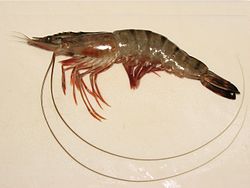| Old scientific name | New scientific name | Common name(s) |
|---|
| P. aztecus | Farfantepenaeus aztecus | northern brown shrimp |
| P. brasiliensis | Farfantepenaeus brasiliensis | red-spotted shrimp, spotted pink shrimp |
| P. brevirostris | Farfantepenaeus brevirostris | crystal shrimp, pink shrimp |
| P. californiensis | Farfantepenaeus californiensis | yellowleg shrimp, brown shrimp |
| P. chinensis | Fenneropenaeus chinensis | fleshy prawn, Chinese white shrimp, oriental shrimp |
| P. orientalis |
| P. duorarum | Farfantepenaeus duorarum | northern pink shrimp |
| P. esculentus | Penaeus esculentus | brown tiger prawn |
| P. hathor | Penaeus hathor | |
| P. indicus | Fenneropenaeus indicus | Indian prawn |
| P. japonicus | Marsupenaeus japonicus | Kuruma shrimp, Kuruma prawn, Japanese tiger shrimp |
| P. merguiensis | Fenneropenaeus merguiensis | banana shrimp, banana prawn |
| P. monodon | Penaeus monodon | giant tiger prawn, black tiger shrimp |
| P. notialis | Farfantepenaeus notialis | southern pink shrimp |
| P. occidentalis | Litopenaeus occidentalis | western white shrimp |
| P. paulensis | Farfantepenaeus paulensis | São Paulo shrimp, Carpas shrimp |
| P. penicillatus | Fenneropenaeus penicillatus | redtail prawn |
| P. schmitti | Litopenaeus schmitti | southern white shrimp |
| P. semisulcatus | Penaeus semisulcatus | green tiger prawn |
| P. setiferus | Litopenaeus setiferus | northern white shrimp |
| P. silasi | Fenneropenaeus silasi | |
| P. stylirostris | Litopenaeus stylirostris | western blue shrimp, blue shrimp |
| P. subtilis | Farfantepenaeus subtilis | southern brown shrimp |
| P. vannamei | Litopenaeus vannamei | whiteleg shrimp, Pacific white shrimp, King prawn |
